|
The
Top 5 Men's Men of the Golden Age
by Derek Sprang
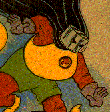 When
I was growing up in Reeseville, comic book superheroes
were really the best role models I had. Everything
I know about being a man came from that four-color
world, which may be one reason I still cherish those
old comics handed down to me by my bachelor uncle.
They taught him, too. When
I was growing up in Reeseville, comic book superheroes
were really the best role models I had. Everything
I know about being a man came from that four-color
world, which may be one reason I still cherish those
old comics handed down to me by my bachelor uncle.
They taught him, too.
Certainly,
those comics have made me a better father. Though
it's certainly great to be able to laugh at some
of the quaint notions of the past, I think it my
duty as a comic book fan to counter Griep's article.
full
article.. .
Commander
Courage: Proud Symbol of Conservation
by Donald Swan
 When
Jackson Whitney created Commander Courage, the young
artist threw in a lot of his personal obsessions.
A dash of patriotism runs through that classic original
run, of course, just like many comics of the time.
Keeping pace with those early stories is a deep
sense of our nation's history, far more accurately
portrayed than most superhero comics of the time,
even with a sensationalized (by modern standards)
portrayal of the attack on Pearl Harbor. That wound
was still too fresh, and too little really known
about it at the time. When
Jackson Whitney created Commander Courage, the young
artist threw in a lot of his personal obsessions.
A dash of patriotism runs through that classic original
run, of course, just like many comics of the time.
Keeping pace with those early stories is a deep
sense of our nation's history, far more accurately
portrayed than most superhero comics of the time,
even with a sensationalized (by modern standards)
portrayal of the attack on Pearl Harbor. That wound
was still too fresh, and too little really known
about it at the time.
The
one aspect of Commander Courage's world given short
shrift would turn out to be the thing that set the
character apart from other popular heroes like Captain
America, The Shield, and Superman. From the very
beginning of the strip, Jackson tried to ensure
that his hero represented a deep reverence for nature,
just as the Wisconsin autodidact had developed through
his own studies.
full
article...
The
Code That Killed The Golden Age
by Donald Swan
 A
lot of people talk about the Comics Code Authority
and the effect it had on the industry. But I don't
think very many people have actually read the code.
Of course its intention was noble and there are
many laudable ideals set out in it. Other restrictions
may seem laughable to our modern tastes but we have
to bear in mind it was a more innocent age... A
lot of people talk about the Comics Code Authority
and the effect it had on the industry. But I don't
think very many people have actually read the code.
Of course its intention was noble and there are
many laudable ideals set out in it. Other restrictions
may seem laughable to our modern tastes but we have
to bear in mind it was a more innocent age...
full
article...
The
Top 5 Not-So-Latently-Gay Golden-Age Superheroes
by Terrance Griep
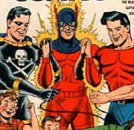 5)
THE RED BEE. Oh, I know you think you had this one
nailed because of the pink sleeves, but you're buzzing
up the wrong hive. See, the Apis Avenger keeps a
swarm of trained bees—including his favorite,
named Michael, unnaturally enough—in his belt.
His belt! Accessorizing like this says two words,
my little drones: wayyy gayyy. 5)
THE RED BEE. Oh, I know you think you had this one
nailed because of the pink sleeves, but you're buzzing
up the wrong hive. See, the Apis Avenger keeps a
swarm of trained bees—including his favorite,
named Michael, unnaturally enough—in his belt.
His belt! Accessorizing like this says two words,
my little drones: wayyy gayyy.
4)
BLACK CANARY. Yes, you read that right. This one's
so obvious, even Doctor Mid-Nite could see it (or
should). "She" spent all that time dating
a Queen... that's Queen with a capital "Q."
And the lace stockings..? The proof is as sharp
as a pre-Crisis Canary Cry: clearly, Black Canary
is a gay transvestite.
full
article
When
Marvel Was Timely: Part 2 -- The Big Three
by Jason Sacks
 The
king of Atlantis. A robot who could burst into flames.
And America’s first super-soldier. The Sub-Mariner,
the Human Torch and Captain America were by far
the most popular heroes to emerge from Timely Comics
in the 1940s. The
king of Atlantis. A robot who could burst into flames.
And America’s first super-soldier. The Sub-Mariner,
the Human Torch and Captain America were by far
the most popular heroes to emerge from Timely Comics
in the 1940s.
Timely,
which would in the 1960s become known as Marvel
Comics, was a second-tier publisher during World
War II.
full
article
Catwoman,
First Lady of Crime
by Daniel DeFabio
 People
can argue for days over the greatest superhero:
Superman, Spider-Man, Captain Marvel, Green Lantern,
Batman, maybe the Hulk. People
can argue for days over the greatest superhero:
Superman, Spider-Man, Captain Marvel, Green Lantern,
Batman, maybe the Hulk.
But
when it comes to female super-villains there can
be only one name at the top of the list: Catwoman.
The whipsmart sexy foil to Bruce Wayne’s Dark
Knight first seduced comic fans in 1940. .
full
article .
One
For The Ages: Barbara Gordon
and the (Il)Logic of Comic Book Age-Dating
by A. David Lewis
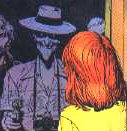 When
undertaking the question of the comic book Ages,
one could look no further than a character from
that selfsame medium, Barbara Gordon, as a guide.
Best known as DC Comics' Batgirl, Barbara Gordon
provides a useful entry point into the discussion
of comic book classification and dating nomenclature. When
undertaking the question of the comic book Ages,
one could look no further than a character from
that selfsame medium, Barbara Gordon, as a guide.
Best known as DC Comics' Batgirl, Barbara Gordon
provides a useful entry point into the discussion
of comic book classification and dating nomenclature.
The
heroine long ago hung up her chiropteran tights
out of necessity: a gunshot would to the spine left
the librarian-by-day/vigilante-by-night permanently
paralyzed from the waist down.
Page
1, Page 2, Page
3, chart and citations
When
Marvel Was Timely: Part 1 -- The Second-stringers
by Jason Sacks
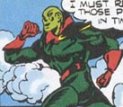 In
the 1940s Marvel Comics weren’t Marvel Comics.
They
were called Timely Comics, and by and large, their
line was very forgettable. After their big three
heroes of Captain America, the Human Torch and the
Sub-Mariner, most of the rest of Timely’s
heroes were just plain goofy. In
the 1940s Marvel Comics weren’t Marvel Comics.
They
were called Timely Comics, and by and large, their
line was very forgettable. After their big three
heroes of Captain America, the Human Torch and the
Sub-Mariner, most of the rest of Timely’s
heroes were just plain goofy.
Unlike
DC and Fawcett, who ruled the roost in that era,
none of Timely’s second tier characters captured
the public’s imagination at all. DC had Hawkman
and the Flash and Starman as second-tier characters,
while Fawcett’s Marvel Family of characters
even spawned a funny animal title in Hoppy
the Marvel Bunny. But Timely, in the 1940s a
second-rate publisher, lagged behind.
full
article.. .
Defender
of the Southern Faith: When Walked The Reverend...
by Christopher J. Garcia
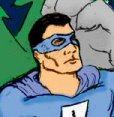 Of
all the characters that have graced the shelves
of grocery stores and newsstands the world over,
none captured the feel of the post-bellum South
so much as The Reverend. From the cross that burned
on his chest when evil approached, to the eyes of
the demons that he battled tooth and nail, The Reverend's
seven-year run made him a favorite of children around
the country, but especially those who read beneath
the covers in former Georgia plantation homes. Of
all the characters that have graced the shelves
of grocery stores and newsstands the world over,
none captured the feel of the post-bellum South
so much as The Reverend. From the cross that burned
on his chest when evil approached, to the eyes of
the demons that he battled tooth and nail, The Reverend's
seven-year run made him a favorite of children around
the country, but especially those who read beneath
the covers in former Georgia plantation homes.
The
Reverend, written originally by Hap Hanland, appeared
for the first time on the back page of In Your Defense,
a popular American war comic, during the early months
of WWII. Shown defending the stately homes of Savannah
from Japanese air attack, The Reverend came to the
rescue, and flew off with the cry "always keep
the faith!"
full
article...
The
Naked Censorship of Liberty Lad
by Donald Swan
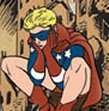 Though
his own courage shortened his career in comics,
Jackson Whitney had a keen grasp of what the burgeoning
superhero field would need. In the very first Commander
Courage story, "The Origin of Commander Courage,"
Whitney had fleshed out polio-stricken junior high
school teacher Jefferson Dale's supporting cast.
No mere crutches these, the staff and students of
Nathan Hale Junior High would each and every one
prove to be crucial to the mythos of Commander Courage.
(First of Two Parts) Though
his own courage shortened his career in comics,
Jackson Whitney had a keen grasp of what the burgeoning
superhero field would need. In the very first Commander
Courage story, "The Origin of Commander Courage,"
Whitney had fleshed out polio-stricken junior high
school teacher Jefferson Dale's supporting cast.
No mere crutches these, the staff and students of
Nathan Hale Junior High would each and every one
prove to be crucial to the mythos of Commander Courage.
(First of Two Parts)
full
article...
Liberty
Wears Long Pants
by Donald Swan
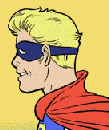 As
figures of wish-fulfilling inspiration, superheroes
should have been invulnerable to the psychologist's
stare. Dr. Wertham slid innuendo towards them. Specifically,
he cited Bruce Wayne and Dick Grayson's relationship
as a "homosexual dream." And of course, generally,
that tarred an entire genre. As
figures of wish-fulfilling inspiration, superheroes
should have been invulnerable to the psychologist's
stare. Dr. Wertham slid innuendo towards them. Specifically,
he cited Bruce Wayne and Dick Grayson's relationship
as a "homosexual dream." And of course, generally,
that tarred an entire genre.
It
didn't help that within the industry, some jokes
had been made about guys like Sam Clay, who did
seem to create an awful lot of boy sidekicks the
moment he'd inherit a feature. McNeal almost certainly
would have been among those making remarks, arching
his eyebrows and lifting his pinky in jest. Talk
to many old-timers now, and they'll still express
regret over the "ribbing" they gave Clay in particular,
ribbing that was none too subtle and eventually,
none too contained when the government came sniffing
around. (Second
of Two Parts)
full
article...
A
Once Upon A Dime Classic!
The
Golden Age of Batman
by Carr D'angelo
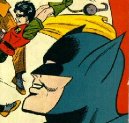 The
Batman origin dreamed up by Finger and Kane is now
a standard of the genre. Ten-year-old Bruce Wayne
watches in horror as his mother and father are gunned
down by a petty thief. Raked with grief, the heir
to the Wayne fortune swears to wage a neverending
war against crime. He prepares his entire life for
this crusade. The
Batman origin dreamed up by Finger and Kane is now
a standard of the genre. Ten-year-old Bruce Wayne
watches in horror as his mother and father are gunned
down by a petty thief. Raked with grief, the heir
to the Wayne fortune swears to wage a neverending
war against crime. He prepares his entire life for
this crusade.
And
once he gains sufficient strength and knowledge
to fight crime, the adult Wayne realizes there's
one more thing he needs: a disguise that will "strike
terror into [the] hearts" of the underworld.
As if an omen, a bat crashes through his window
and Bruce Wayne thus decides to become the Bat-Man.
full
article...
Jack
Cole: A Life In Four Colors
by Donald Swan
 A
comics giant with an amazing ability, Jack Cole
was one of those virtuosos who could do vastly different
styles. He might have three different fanbases.
One loves all his voluptuous incredibly sexy women
in Playboy, done in water colors and oils. He did
a newspaper strip that was minimalist like Peanuts
called “Betsy and Me”, a droll domestic
situation comedy. A
comics giant with an amazing ability, Jack Cole
was one of those virtuosos who could do vastly different
styles. He might have three different fanbases.
One loves all his voluptuous incredibly sexy women
in Playboy, done in water colors and oils. He did
a newspaper strip that was minimalist like Peanuts
called “Betsy and Me”, a droll domestic
situation comedy.
And
of course, he did Plastic Man, which marked the
dawn of a completely different style in comics.
He found incredible inventive ways to use Plastic
Man’s body.
Yet
Cole in his bio would say “I worked for 11
years in comic books” never even mentioning
his most famous creation: Plastic Man. It’s
astonishing.
full
article...
Jay
Garrick Saved My Life
by Vin Miller
 The
year was 1978. I was 10 years old and had just received
the greatest birthday present of my young life:
the Synco Junior Scientist chemistry kit. My parents
had cleared out a corner of the garage for me to
use as a sort of mini-laboratory, and I spent that
first humid afternoon of the summer mixing the blue
and yellow liquids into thin clear glass vials,
then dutifully hanging them over the three tiny
bunsen burners. The
year was 1978. I was 10 years old and had just received
the greatest birthday present of my young life:
the Synco Junior Scientist chemistry kit. My parents
had cleared out a corner of the garage for me to
use as a sort of mini-laboratory, and I spent that
first humid afternoon of the summer mixing the blue
and yellow liquids into thin clear glass vials,
then dutifully hanging them over the three tiny
bunsen burners.
full
article....
The
Beauty Queen of the Crimefighting Set
by Derek Sprang
 With
comic books as the hottest commodity in Hollywood
why hasn't there been any talk of a Mary Medusa
movie? As a long time Mary Medusa fan, I've dreamed
of seeing the Make-up Marvel in living Technicolor
deploy her HairNet or toss a LipBomb. With
comic books as the hottest commodity in Hollywood
why hasn't there been any talk of a Mary Medusa
movie? As a long time Mary Medusa fan, I've dreamed
of seeing the Make-up Marvel in living Technicolor
deploy her HairNet or toss a LipBomb.
Of
course I realize that Mary Medusa may not have the
same pop culture cache that some of the more current
spandex crimebusters have, but she has always held
on to an important piece of my heart. For those
of you who don't know your comics history, let me
tell you about one of the classiest lady crimefighters
to ever bust up a counterfeit cosmetics ring.
full
article...
There's
Something About The Golden Age...
by Stephen Sonneveld
 With
the industry being just as capitalistic in the Depression
and War Years as it is today, what makes the Golden
Age so special? Is it because of the industry’s
unparalleled growth and success at that time? Is
it the creative explosion, the fact than an art
form was coming into it’s own? While those
are certainly part of the mystique, I think the
answer is much simpler: the world needed “super”
heroes. With
the industry being just as capitalistic in the Depression
and War Years as it is today, what makes the Golden
Age so special? Is it because of the industry’s
unparalleled growth and success at that time? Is
it the creative explosion, the fact than an art
form was coming into it’s own? While those
are certainly part of the mystique, I think the
answer is much simpler: the world needed “super”
heroes.
Some
say that the Golden Age is a more innocent time.
I disagree. I think the pre-Code books reveal a
sophistication and worldview that is noticeably
stifled post-Code. The Depression Era heroes were
not insulated within their own worlds, or, in the
case of Spider-Man, their own heads. While names
of cities and countries might have been fictionalized,
the Golden Age heroes were firmly entrenched in
the reader’s world, and fought for the greater
good of it.
full
article....
The
Spirit: A Visionary Character...
by
Jason Sacks
 Out
of the thousands of heroes that first appeared in
comics' golden age, only the most original and exciting
ones have survived to the present day. The list
of such classic characters is short - Captain America,
Sub-Mariner, Wonder Woman, Batman, Superman and
a very few others. Out
of the thousands of heroes that first appeared in
comics' golden age, only the most original and exciting
ones have survived to the present day. The list
of such classic characters is short - Captain America,
Sub-Mariner, Wonder Woman, Batman, Superman and
a very few others.
Each
of those heroes may have each sprung from the forehead
of one creator, but all were eventually absorbed
by the comics corporations. Only one hero stands
alone as an exception to that rule. He is a protagonist
who has appeared in few new stories since 1952 -
a special man called the Spirit.
full
article...
The
Puckish Pranksters We Love To Hate...
by Daniel DeFabio
 Whether
it's Mr. Mxyzptlk, The Impossible Man, or Jinxor,
we all know when a comic book has gone too far to
the silly side. These characters can’t be
taken seriously. Can they? Occasionally a writer
will use them in an interesting new way (Mojo in
the X-men stories), but more often we readers are
left to grin and bear it. Whether
it's Mr. Mxyzptlk, The Impossible Man, or Jinxor,
we all know when a comic book has gone too far to
the silly side. These characters can’t be
taken seriously. Can they? Occasionally a writer
will use them in an interesting new way (Mojo in
the X-men stories), but more often we readers are
left to grin and bear it.
full
article...
|